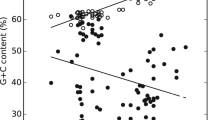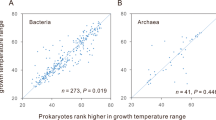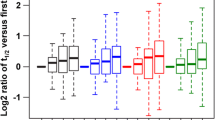Abstract
The purine-loading index (PLI) is the difference between the numbers of purines (A+G) and pyrimidines (T+C) per kilobase of single-stranded nucleic acid. By purine-loading their mRNAs organisms may minimize unnecessary RNA–RNA interactions and prevent inadvertent formation of "self" double-stranded RNA. Since RNA–RNA interactions have a strong entropy-driven component, this need to minimize should increase as temperature increases. Consistent with this, we report for 550 prokaryotic species that optimum growth temperature is related to the average PLI of open reading frames. With increasing temperature prokaryotes tend to acquire base A and lose base C, while keeping bases T and G relatively constant. Accordingly, while the PLI increases, the (G+C)% decreases. The previously observed positive correlation between (G+C)% and optimum growth temperature, which applies to RNA species whose structure is of major importance for their function (ribosomal and transfer RNAs) does not apply to mRNAs, and hence is unlikely to apply generally to genomic DNA.




Similar content being viewed by others
Abbreviations
- CUTG:
-
Codon usage tables from GenBank
- ΔS:
-
Chargaff difference for the S bases ("GC skew")
- ΔW:
-
Chargaff difference for the W bases ("AT skew")
- ORF:
-
Open reading frame
- PLI:
-
Purine-loading index
References
Barrette IH, McKenna S, Taylor DR, Forsdyke DR (2001) Introns resolve the conflict between base order-dependent stem-loop potential and the encoding of RNA or protein: further evidence from overlapping genes. Gene 270:181–189
Bell SJ, Forsdyke DR (1999a) Accounting units in DNA. J Theor Biol 197:51–61
Bell SJ, Forsdyke DR (1999b) Deviations from Chargaff's second parity rule correlate with direction of transcription. J Theor Biol 197:63–76
Bernardi G (2000) Isochores and the evolutionary genomics of vertebrates. Gene 241:3–17
Bernardi G, Bernardi G (1986) Compositional constraints and genome evolution. J Mol Evol 24:1–11
Cambillau C, Claverie J-M (2000) Structural and genomic correlates of hyperthermostability. J Biol Chem 275:32383–32386
Cantor CR, Schimmel PR (1980) Statistical mechanics and kinetics of nucleic acid interactions. In: Biophysical chemistry. Freeman, San Francisco, pp 1183–1264
Cristillo AD, Mortimer JR, Barrette IH, Lillicrap TP, Forsdyke DR (2001) Double-stranded RNA as a not-self alarm signal: to evade, most viruses purine-load their RNAs, but some (HTLV-1, EBV) pyrimidine-load. J Theor Biol 208:475–491
Dalgaard JZ, Garrett A (1993) Archaeal hyperthermophile genes. In: Kates M, Kushner DJ, Matheson AT (eds) The biochemistry of Archaea (Archaebacteria), Elsevier, Amsterdam, pp 535–562
D'Onofrio G, Jabbari K, Musto H, Bernardi G (1999) The correlation of protein hydropathy with the base composition of coding sequences. Gene 238:3–14
Eigen M, Schuster P (1978) The hypercycle. A principle of natural self-organization, part C. The realistic hypercycle. Naturwissenschaften 65:341–369
Forsdyke DR (1995) Entropy-driven protein self-aggregation as the basis for self/not-self discrimination in the crowded cytosol. J Biol Sys 3:273–287
Forsdyke DR (1996) Different biological species "broadcast" their DNAs at different (C+G)% "wavelengths". J Theor Biol 178:405–417
Forsdyke DR (1998) An alternative way of thinking about stem-loops in DNA. A case study of the G0S2 gene. J Theor Biol 192:489–504
Forsdyke DR (1999) Two levels of information in DNA. Relationship of Romanes' "intrinsic" variability of the reproductive system, and Bateson's "residue", to the species-dependent component of the base composition, (C+G)%. J Theor Biol 201: 47–61
Forsdyke DR (2001a) The origin of species, revisited. McGill-Queen's University Press, Montreal
Forsdyke DR (2001b) Functional constraint and molecular evolution. In: Nature encyclopedia of life sciences, vol 7. Nature Publishing, London, pp 396–403
Forsdyke DR (2002a) Symmetry observations in long nucleotide sequences. Bioinformatics 18:215–217
Forsdyke DR (2002b) Selective pressures that decrease synonymous mutations in Plasmodium falciparum. Trends Parasitol 18:411–418
Forsdyke DR, Mortimer JR (2000) Chargaff's legacy. Gene 261:127–137
Forterre P, Elie C (1993) Chromosome structure, DNA topoisomerases, and DNA polymerases in Archaebacteria (Archaea). In: Kates M, Kushner DJ, Matheson AT (eds) The biochemistry of Archaea (Archaebacteria). Elsevier, Amsterdam, pp 325–345
Fukuchi S, Nishikawa K (2001) Protein surface amino acid compositions distinctively differ between thermophilic and mesophilic bacteria. J Mol Biol 309:835–843
Galtier N, Lobry JR (1997) Relationships between genomic G+C content, RNA secondary structures, and optimal growth temperature in prokaryotes. J Mol Evol 44:632–636
Grantham R (1980) Workings of the genetic code. Trends Biochem Sci 5:327–331
Grove A, Lim L (2001) High affinity DNA binding of HU protein from the hyperthermophile Thermotoga maritime. J Mol Biol 311:491–502
Hurst LD, Merchant AR (2001) High guanine-cytosine content is not an adaptation to high temperature: a comparative analysis among prokaryotes. Proc R Soc Lond B 268:493–497
Jaenicke R, Bohm G (1998) The stability of proteins in extreme environments. Curr Opin Struct Biol 8:738–748
Jenkins JM, Pagel M, Gould EA, Zanotto PM de A, Holmes EC (2001) Evolution of base composition and codon usage bias in the genus Flavivirus. J Mol Evol 52:383–390
Knight RD, Freeland SJ, Landweber LF (2001) A simple model based on mutation and selection explains trends in codon and amino-acid usage and GC composition within and across genomes. Genome Biol 2:0010.1–0010.13
Lao PJ, Forsdyke DR (2000) Thermophilic bacteria strictly obey Szybalski's transcription direction rule and politely purine-load RNAs with both adenine and guanine. Genome Res 10:228–236
Lauffer MA (1975) Entropy-driven processes in biology. Springer, Berlin Heidelberg New York
Lobry JR, Chessel D (2003) Internal correspondence analysis of codon and amino-acid usage in thermophilic bacteria. J Appl Genet 44:235–261
Mortimer JR, Forsdyke DR (2003) Comparison of responses by bacteriophage and bacteria to pressures on the base composition of open reading frames. Appl Bioinformatics 2:47–62
Nakamura Y, Gojobori T, Ikemura T (2000) Codon usage tabulated from the international DNA sequence databases: status for the year 2000. Nucleic Acids Res 28:292
Pizzi E, Frontali C (2001) Low-complexity regions in Plasmodium falciparum proteins. Genome Res 11:218–229
Ream RA, Johns GC, Somero GN (2003) Base compositions of genes encoding α-actin and lactate dehydrogenase-A from differently adapted vertebrates show no temperature-adaptive variation in G+C content. Mol Biol Evol 20:105–110
Saccone C, Gissi C, Lanave C, Larizza A, Pesole G, Reyes A (2000) Evolution of the mitochondrial genetic system: an overview. Gene 261:153–159
Shepherd JCW (1981) Method to determine the reading frame of a protein from the purine/pyrimidine genome sequence and its possible evolutionary justification. Proc Natl Acad Sci U S A 78:1596–1600
Sicot F-X, Mesnage M, Masselot M, Exposito J-Y, Garrone R, Deutsch J, Gaill F (2000) Molecular adaptation to an extreme environment: origin of the thermal stability of the Pompeii worm collagen. J Mol Biol 302:811–820
Smithies O, Engels WR, Devereux JR, Slightom JL, Chen S-H (1981) Base substitutions, length differences and DNA strand asymmetries in the human Gγ and Aγ fetal globin gene region. Cell 26:345–353
Stetter KO (1999) Extremophiles and their adaptation to hot environments. FEBS Lett 452:22–25
Szybalski W, Kubinski H, Sheldrick O (1966) Pyrimidine clusters on the transcribing strand of DNA and their possible role in the initiation of RNA synthesis. Cold Spring Harb Symp Quant Biol 31:123–127
Xue HY, Forsdyke DR (2003) Low complexity segments in Plasmodium falciparum proteins are primarily nucleic acid level adaptations. Mol Biochem Parasitol 128:21–32
Acknowledgments
We thank James Gerlach, Christopher Madill, Andrew Schramm, and Scott Smith for advice and assistance. Jean Lobry and Daniel Chessel kindly made their paper available prior to publication. Access to the GCG suite of programs was provided by the Canadian Bioinformatics Resource (Halifax). Academic Press, Cold Spring Harbor Laboratory Press, and Elsevier Science gave permissions for the inclusion of full-text versions of some of the cited papers in Forsdyke's web pages, which may be accessed at http://post.queensu.ca/~forsdyke/bioinfor.htm
Author information
Authors and Affiliations
Corresponding author
Additional information
Communicated by F. Robb
Rights and permissions
About this article
Cite this article
Lambros, R.J., Mortimer, J.R. & Forsdyke, D.R. Optimum growth temperature and the base composition of open reading frames in prokaryotes. Extremophiles 7, 443–450 (2003). https://doi.org/10.1007/s00792-003-0353-4
Received:
Accepted:
Published:
Issue Date:
DOI: https://doi.org/10.1007/s00792-003-0353-4




